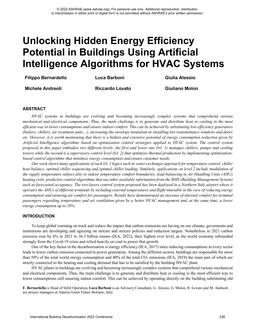
C30 — Unlocking Hidden Energy Efficiency Potential in Buildings Using Artificial Intelligence Algorithms for HVAC Systems
- Comments Off on C30 — Unlocking Hidden Energy Efficiency Potential in Buildings Using Artificial Intelligence Algorithms for HVAC Systems
- ASHRAE
Click here to purchase
HVAC systems in buildings are evolving and becoming increasingly complex systems that comprehend various mechanical and electrical components. Thus, the main challenge is to generate and distribute heat or cooling in the most efficient way to lower consumptions and ensure indoor comfort. This can be achieved by substituting low-efficiency generators (boilers, chillers, air treatment units…), increasing the envelope insulation or installing low transmittance windows and doors etc. However, it is worth mentioning that there is a hidden and extensive potential of energy consumption reduction given by Artificial Intelligence algorithms based on optimization control strategies applied to HVAC system. The control system proposed in this paper embodies two different levels: the first and lower one (lvl. 1) manages chillers, pumps and cooling towers while the second is a supervisory control level (lvl. 2) that optimizes thermal production by implementing optimizationbased control algorithms that minimize energy consumption and ensure customer needs. Our work shows many applications of such lvl. 1 logics such as water exchanger approach for temperature control, chiller heat balance, optimal chiller sequencing and optimal chiller loading. Similarly, applications on level 2 include modulation of the supply temperature subject also to indoor temperature comfort boundaries, load balancing in Air Handling Units (AHU) heating coils, predictive control algorithms that use other available information from the BMS (Building Management System) such as forecasted occupancy. The two-layers control system proposed has been deployed in a Northern Italy airport where it operates the AHUs of different terminals by including external temperatures and flight timetable in the view of reducing energy consumption and ensuring air comfort for passengers. Results have demonstrated an increase of internal comfort for terminal passengers regarding temperature and air ventilation given by a better HVAC management and, at the same time, a lower energy consumption up to 58%.
Product Details
- Published:
- 2022
- Number of Pages:
- 9
- Units of Measure:
- Dual
- File Size:
- 1 file , 1.3 MB
- Product Code(s):
- D-94056-C30
- Note:
- This product is unavailable in Russia, Belarus

